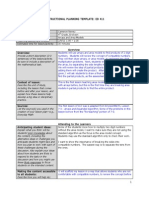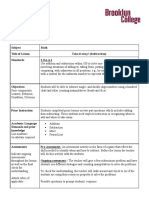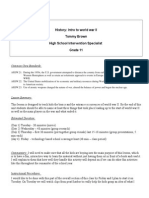Danias Lesson
Danias Lesson
Uploaded by
api-275091122Copyright:
Available Formats
Danias Lesson
Danias Lesson
Uploaded by
api-275091122Original Title
Copyright
Available Formats
Share this document
Did you find this document useful?
Is this content inappropriate?
Copyright:
Available Formats
Danias Lesson
Danias Lesson
Uploaded by
api-275091122Copyright:
Available Formats
MIAA360: Lesson Study
Team Members:Dania Chandler, Victoria Coburn, Donna Robertson
Teaching Dates:
May 8, 2015 & May 11, 2015
Grade Span:
Identification:
K-3
Extension Lesson-Prior to this lesson, the students worked with numbers up to 200. This lesson is an extension because
the students are working with numbers within 1,000.
Concept for this lesson: Relate manipulative representations to the subtraction algorithm, and use addition to explain why the subtraction method
works.
Stage of Lesson
Teacher Does
Directions or Teacher Questions
ENGAGE
Time: 12 minutes
Day #1
Introduction of Teaching Team and the
plan for the lesson.
Materials:
Student whiteboards
Student Does
Expected Student Responses or
Student Activities
The learning objective and application
problem are introduced and discussed.
MPS:
3. Construct viable arguments and
critique the reasoning of others.
6. Attend to precision.
7. Look for and make use of structure.
8. Look for and express regularity in
repeated reasoning.
Today we will draw math pictures
that relate to subtraction algorithms
and use addition to check our work.
Teacher breaks the objective into
chunks and asks the students to explain
each part.
[In the interest of time, the teacher
could start with a kid-friendly learning
objective instead.]
Standard
CCSSM,MPS, NGSS, 21st Century
(used throughout)
21st Century:
Critical Thinking
Communication
The class comes up with a kid-friendly
learning objective.
We will draw pictures for subtraction
problems and use addition to check our
work.
CCSSM:
2.NBT.9
Add and subtract within 1000, using
concrete models or drawings and
strategies based on place value,
properties of operations, and/or the
relationship between addition and
MIAA360: Lesson Study
To get us started, I would like for you
to think about this problem.
A fruit seller buys a carton of 90
apples. Finding that 18 of them are
rotten, he throws them away. He sells
22 of the ones that are left on Monday.
Now, how many apples does he have
left to sell?
Students are given three minutes to
independently solve the problem on
their whiteboard.
Two students share their strategies
with the class and make comparisons
with the rest of the class.
Teacher reminds the students that they
can use the RDW method (Read,
Draw, Write) or any of the strategies
previously taught. Then the teacher
circulates around the room and selects
two students who solved the problem
using different strategies.
Teacher models using a tape diagram
to solve the problem.
Evaluate
Consider Decision
Points Assessments
Stage of Lesson
EXPLORE
Time: 15 minutes
Materials:
Student whiteboards
[This demonstration could be saved for
the concept development portion of the
lesson because the goal of the
application problem was to evaluate
the strategies that the students know
fluently.]
Teacher Does
Directions or Teacher Questions
The following activities review the
foundational skills that lead into
todays lesson.
What were going to do next is
called-Making the Next Ten?
subtraction;
relate the strategy to a written method.
Understand that in adding or
subtracting three-digit numbers, one
adds or subtracts hundreds and
hundreds, tens and tens, ones and ones;
and sometimes it is necessary to
compose or decompose tens or
hundreds.
2.NBT.9
Explain why addition and subtraction
strategies work, using place value and
the properties of operations.
Student Does
Expected Student Responses or
Student Activities
Standard
CCSSM,MPS, NGSS, 21st Century
(used throughout)
MIAA360: Lesson Study
When I say 9+4, you will write 10+3.
Why didnt I just say 13?
So how did I get 10 +3?
9+4 and 10+3 both equal 13. The
sentences are related.
because the activity is called
Making the Next Ten and the next 10
after 9 is 10.
You took 1 from the 4 and added it to
9. There were 3 from the 4 left over so
you added the ten and the 3 and got
13.
Students practice solving additional
Making the Next Ten equations (19+4,
9+6, 19+6) and discuss patterns that
they notice.
Now lets practice an activity called
Making the Next Hundred.
Evaluate
Consider Decision
Points Assessments
Teacher writes 170 on the board.
Lets find the missing part to make
the next hundred.
What is the next hundred?
If I say 170, you say the number
needed to make 200. Ready? 170.
What was your strategy for finding
the missing part to make 200?
[For the students who have difficulty
remembering the next ten, you can
post the hundred chart with the tens
highlighted and/or show them a
number line the shows the numbers 1
to 100. You can post skip counting by
100s on the board for a reference for
Making the Next Hundred.]
200.
30.
Students respond orally.
I knew that 7+3=10 and 17+3=20, so
I knew 170+30=200.
Some students were confused and
MIAA360: Lesson Study
attempted to write a related sentence
instead of finding the missing part.
Students practice solving additional
Making the Next Hundred equations
(190, 290, 380, 580) and discuss the
patterns that they notice.
Day#2
(The lesson had to be completed on another
day due to the students being distracted by a
student who made a scene moaning loudly,
crying, and tapping on their desk.)
Teacher reviews the learning objective,
draws a blank number bond on the
board and writes
244-121 next to the place value chart.
Lets read the problem together.
How would you complete this
number bond?
What do we need to show on our
place value charts?
When answering a subtraction
problem, what should you remember
to show on the place value chart?
Teacher directs student attention to the
algorithm 244-121 written vertically.
Remember as we solve subtraction
Students will talk to their partners and
they are encouraged to use part-whole
language.
I would put 244 in the whole and 121
in one part. 244 is the whole since we
are subtracting.
Remember to only show the whole
because we are subtracting, not
adding.
Students draw chips on their place
MIAA360: Lesson Study
problems, we are going to record our
work vertically. The drawings on our
place value charts should match the
algorithm.
Lets look at our algorithm. Look
carefully at each place to see if we
have enough units. Move from the one
to the tens to the hundreds place.
Looking at the number bond, come up
with a related addition problem to
check our answer.
value chart (2 circles in the hundreds
place, 4 circles in the tens place, 4
circles in the ones place).
[For the kinesthetic modality, use place
value disks for the students to
manipulate before moving on to
drawing place value chips (circles).]
Students will cross out 1 hundred, 2
tens, and 1 one from their place value
charts. Students will record the
subtraction using vertical form and
complete the missing part of the
number bond.
Students will add 123+121 and notice
that the problem is correct because the
two parts that were added together
created the whole (244).
Students will solve and share their
solutions to 244-125 and 312-186.
Stage of Lesson
Teacher Does
Directions or Teacher Questions
EXPLAIN
Time: 30 minutes
Teacher assigns the problem set on
pages 5.C.10 and 5.C.11.
Materials:
Student whiteboards
Student Does
Expected Student Responses or
Student Activities
Students will subtract using the
vertical method and drawing chips on
the place value chart. Students will
check their solutions by adding.
[Use the front page as independent
Standard
CCSSM,MPS, NGSS, 21st Century
(used throughout)
MIAA360: Lesson Study
practice and the back page for an
assessment/Exit Ticket.]
Teacher reviews the learning objective
and debriefs the lesson with the class.
Explain to your partner how you used
number disks to solve Problem 2-d.
Evaluate
Consider Decision
Points Assessments
Students share their responses.
How did your work with the place
value chart/chips match the vertical
subtraction?
How did you use addition today to
explain why the subtraction works?
Stage of Lesson
Teacher Does
Directions or Teacher Questions
EVALUATE
Time: 5 minutes
A formative assessment, in the form of
an Exit Ticket, will help guide the
instruction of future lessons.
Materials:
Whiteboards
Exit Ticket
[The Exit Ticket could also be used as
homework.]
Teacher has ongoing assessment of
student understanding by listening to
student dialogue in the class
discussions, whiteboard responses, and
via written responses for the problem
set.
Student Does
Expected Student Responses or
Student Activities
Students will solve four 3-digit
subtraction problems (using the
vertical method & place value charts)
and check their solutions using
addition.
Students demonstrated their conceptual
understanding on their
whiteboards/place value charts, and
classroom/partner discussion.
Standard
CCSSM,MPS, NGSS, 21st Century
(used throughout)
MIAA360: Lesson Study
Lesson Reflection:
There are areas that I am challenging myself to strengthen, omit, and modify in future lessons.
This is what Ive come up with.
Allow more time for student exploration. Cover less content but dig deeper and make learning more meaningful.
The inquiry questions were effective but the students should be given more think time for their explanations.
Give the students guidance, not hints.
Keep the students actively engaged. Increase the use of random selection (student names on playing cards).
Be mindful that the students already had exposure to the strategies used in this lesson. They are building on their prior knowledge. More
scaffolding could be done in a small group setting.
Do not over-teach when being observed or recorded. I must pace myself, stick to the plan, and not over-saturate my instruction.
The lesson study process was enlightening because it helped me to explicitly understand my role as the teacher, which is to create learning
opportunities that build upon what the students already know. Using the 5E Model made lesson planning more purposeful and made my teaching
more focused.
You might also like
- FEU Policies and Guidelines For Grading and Assessment Min MinNo ratings yetFEU Policies and Guidelines For Grading and Assessment Min Min14 pages
- Lesson Plan: Step 1: Curriculum ConnectionsNo ratings yetLesson Plan: Step 1: Curriculum Connections5 pages
- Formal Observation 1 - 10-4 Dividing 2digit by 1digit NumbersNo ratings yetFormal Observation 1 - 10-4 Dividing 2digit by 1digit Numbers9 pages
- Lesson Plan: Formative: The Minute Math Drill Will Allow The Teacher To See HowNo ratings yetLesson Plan: Formative: The Minute Math Drill Will Allow The Teacher To See How3 pages
- Lesson Plan: Tennessee Curriculum Subject: Mathematics Level: 4 Standard: Standard 2 - Number and OperationsNo ratings yetLesson Plan: Tennessee Curriculum Subject: Mathematics Level: 4 Standard: Standard 2 - Number and Operations4 pages
- Lesson Plan Template: Common Core State StandardsNo ratings yetLesson Plan Template: Common Core State Standards17 pages
- Lesson Plan: Step 1: Curriculum ConnectionsNo ratings yetLesson Plan: Step 1: Curriculum Connections4 pages
- Area Model Math Lesson Plan Fourth GradeNo ratings yetArea Model Math Lesson Plan Fourth Grade6 pages
- Cbse7681 Fall20 - Lessonplan-Final Sem 1No ratings yetCbse7681 Fall20 - Lessonplan-Final Sem 14 pages
- Grade Level: 4th Grade Curriculum Resource(s)No ratings yetGrade Level: 4th Grade Curriculum Resource(s)5 pages
- W200 Service-Learning Project Lesson Plan:: Brandon Willy (Bwilly@indiana - Edu) Step I: Project InformationNo ratings yetW200 Service-Learning Project Lesson Plan:: Brandon Willy (Bwilly@indiana - Edu) Step I: Project Information9 pages
- Lesson Study Final Report Part I: Background Lesson TopicNo ratings yetLesson Study Final Report Part I: Background Lesson Topic9 pages
- Lesson Plan Title: Problem Solving in MathematicsNo ratings yetLesson Plan Title: Problem Solving in Mathematics10 pages
- Teacher Candidate Kassara Stratton Grade Level 4 Title DECIMALS UNIT Lesson 2No ratings yetTeacher Candidate Kassara Stratton Grade Level 4 Title DECIMALS UNIT Lesson 24 pages
- Alternate Lesson Plan Format - Student TeachingNo ratings yetAlternate Lesson Plan Format - Student Teaching2 pages
- Question Analysis, Design, and Implementation Project by Donna RobertsonNo ratings yetQuestion Analysis, Design, and Implementation Project by Donna Robertson2 pages
- (Appendix C-03) COT-RPMS Rating Sheet For T I-III For SY 2023-202496% (50)(Appendix C-03) COT-RPMS Rating Sheet For T I-III For SY 2023-20241 page
- Classroom Strategies: A. Round Table DiscussionNo ratings yetClassroom Strategies: A. Round Table Discussion3 pages
- Lesson Plan: (ACE Science Physics (PHY7104) / PRESSURE)No ratings yetLesson Plan: (ACE Science Physics (PHY7104) / PRESSURE)6 pages
- Classroom Observation and Evaluation of Course Materials For Assistant Professor Matthew HerbertzNo ratings yetClassroom Observation and Evaluation of Course Materials For Assistant Professor Matthew Herbertz2 pages
- Experiencing The Teaching and Learning Process Episode 1 Learning Through The Meaningful Learning ProcessNo ratings yetExperiencing The Teaching and Learning Process Episode 1 Learning Through The Meaningful Learning Process16 pages
- Name: Claivan Jade Rejuso Jabajab Year/Section/Course: 2 - A BEEDNo ratings yetName: Claivan Jade Rejuso Jabajab Year/Section/Course: 2 - A BEED2 pages
- K-12 Lesson Plan For Demo Teaching RAMILNo ratings yetK-12 Lesson Plan For Demo Teaching RAMIL2 pages
- Take-Home Final Examination May 2021 Semester: NUR HABIBAH BT YUSUF (A30105200007)No ratings yetTake-Home Final Examination May 2021 Semester: NUR HABIBAH BT YUSUF (A30105200007)22 pages
- Frameworks For Technological IntegrationNo ratings yetFrameworks For Technological Integration9 pages
- (Taken From The Curriculum Guide) : M11GM-lla-1 M11GM-lla-2 M11GM-lla-b-1 M11GM-llb-2No ratings yet(Taken From The Curriculum Guide) : M11GM-lla-1 M11GM-lla-2 M11GM-lla-b-1 M11GM-llb-27 pages
- Ruhehe Primary School / MASS Design Group: RuhengeriNo ratings yetRuhehe Primary School / MASS Design Group: Ruhengeri5 pages
- FEU Policies and Guidelines For Grading and Assessment Min MinFEU Policies and Guidelines For Grading and Assessment Min Min
- Formal Observation 1 - 10-4 Dividing 2digit by 1digit NumbersFormal Observation 1 - 10-4 Dividing 2digit by 1digit Numbers
- Lesson Plan: Formative: The Minute Math Drill Will Allow The Teacher To See HowLesson Plan: Formative: The Minute Math Drill Will Allow The Teacher To See How
- Lesson Plan: Tennessee Curriculum Subject: Mathematics Level: 4 Standard: Standard 2 - Number and OperationsLesson Plan: Tennessee Curriculum Subject: Mathematics Level: 4 Standard: Standard 2 - Number and Operations
- W200 Service-Learning Project Lesson Plan:: Brandon Willy (Bwilly@indiana - Edu) Step I: Project InformationW200 Service-Learning Project Lesson Plan:: Brandon Willy (Bwilly@indiana - Edu) Step I: Project Information
- Lesson Study Final Report Part I: Background Lesson TopicLesson Study Final Report Part I: Background Lesson Topic
- Teacher Candidate Kassara Stratton Grade Level 4 Title DECIMALS UNIT Lesson 2Teacher Candidate Kassara Stratton Grade Level 4 Title DECIMALS UNIT Lesson 2
- Question Analysis, Design, and Implementation Project by Donna RobertsonQuestion Analysis, Design, and Implementation Project by Donna Robertson
- (Appendix C-03) COT-RPMS Rating Sheet For T I-III For SY 2023-2024(Appendix C-03) COT-RPMS Rating Sheet For T I-III For SY 2023-2024
- Lesson Plan: (ACE Science Physics (PHY7104) / PRESSURE)Lesson Plan: (ACE Science Physics (PHY7104) / PRESSURE)
- Classroom Observation and Evaluation of Course Materials For Assistant Professor Matthew HerbertzClassroom Observation and Evaluation of Course Materials For Assistant Professor Matthew Herbertz
- Experiencing The Teaching and Learning Process Episode 1 Learning Through The Meaningful Learning ProcessExperiencing The Teaching and Learning Process Episode 1 Learning Through The Meaningful Learning Process
- Name: Claivan Jade Rejuso Jabajab Year/Section/Course: 2 - A BEEDName: Claivan Jade Rejuso Jabajab Year/Section/Course: 2 - A BEED
- Take-Home Final Examination May 2021 Semester: NUR HABIBAH BT YUSUF (A30105200007)Take-Home Final Examination May 2021 Semester: NUR HABIBAH BT YUSUF (A30105200007)
- (Taken From The Curriculum Guide) : M11GM-lla-1 M11GM-lla-2 M11GM-lla-b-1 M11GM-llb-2(Taken From The Curriculum Guide) : M11GM-lla-1 M11GM-lla-2 M11GM-lla-b-1 M11GM-llb-2
- Ruhehe Primary School / MASS Design Group: RuhengeriRuhehe Primary School / MASS Design Group: Ruhengeri

































































































